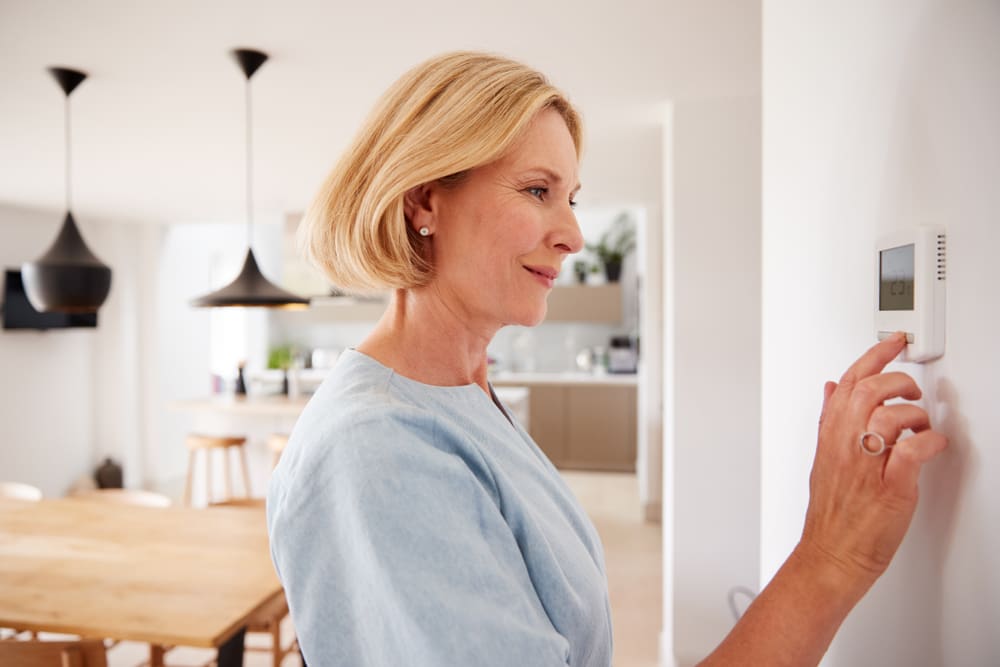
For many people, wintertime is the perfect occasion for traveling. While you’re home, you likely keep your thermostat at a comfortable level. However, if you plan to leave home for vacation to escape the cold or visit loved ones for the holidays, you might ask, “What temperature should I leave my heat on during the winter?”
At Hurley & David, our HVAC technicians know what temperature to leave a vacant house in the winter and why it’s necessary to adjust the thermostat before going away for any extended period. We’ll explain what you should know about winter temperature adjustments when no one is home.

What Temperature to Leave an Empty House in the Winter
People may wonder, “What temperature should I leave my house while on vacation in the winter?” The answer depends on the situation. Properly adjusting your thermostat is necessary to save you money on monthly energy expenses and protect your furnace’s long-term performance.
According to ENERGY STAR, 68 degrees is the ideal temperature to set your thermostat to in the winter while you’re home. That’s warm enough to ensure the heating system keeps you warm without consuming too much energy and raising your utility bills beyond what you’re willing to spend.
Setting the furnace at a higher temperature might provide more warmth for your residence. However, constantly running the system could put undue strain on the equipment, requiring professional furnace repairs.
That brings us to the all-important question: “What temperature should I leave my heat on during winter when no one’s home?” Keep reading for more details.
Minimum Heat Setting for an Empty House
Turn the heat down as low as possible if your house is empty and no one will return for several days. The minimum temperature setting is between 55 and 60 degrees.
Setting the indoor temperature below 55 degrees in the winter could cause problems. Besides being uncomfortably cold, you could be in for a nasty surprise if outdoor temperatures cause your pipes to burst due to expansion and contraction when water freezes.
Frozen plumbing is a major problem for buildings when outdoor temperatures drop too low. Pipes can burst if they freeze, causing a massive flood unless someone can shut off the water. The flooding can lead to substantial water damage and expensive plumbing repairs.
Let your furnace run at a reasonable temperature to provide sufficient warmth and minimize the risk of frozen pipes. If your house is spacious, consider setting the thermostat closer to 60 degrees to ensure adequate heating.

Does Turning off the Heat While Away Save Money?
You might assume turning the furnace off while you’re away will save you money on heating bills. Unfortunately, doing so can have the opposite effect.
Leaving the furnace off for several days will lower the temperature of your entire house. It will take longer for the heating system to reach a comfortable temperature once you return, forcing the furnace to work harder for longer and putting extra stress on the system.
You might not spend much on energy bills at first, but your bills will increase dramatically over time. Turning the heat down is better than turning it off. That way the furnace won’t have to work too hard to reach the normal temperature setting.
Recommended Settings for Short-Term Vacancy
Deciding what temperature to leave your thermostat set to isn’t such a big deal if you’re only going to be away for a day or two. In that case, you can leave the heat set to 60 degrees without worrying about any problems while you’re gone or once you return.
Recommended Settings for Long-Term Vacancy
You can lower the temperature for a longer stay away from your house. If you don’t have concerns about frozen plumbing, you can drop the thermostat to 50 or 55 degrees. For extra protection against unwanted plumbing surprises, drain the water pipes and shut off the water supply.
Save on Heating Costs
Installing a programmable thermostat can help you lower energy costs. These modern devices allow for easy temperature adjustments according to your schedule. Smart thermostats also allow remote access via mobile devices and Wi-Fi, so you can make adjustments wherever you are at any time.

Consider these other tips if you want to know how to save on heating bills each winter:
- Turn down your water heater: To save money on utility bills, you can reduce the temperature on your water heater and furnace. Adjusting the water heater thermostat from 140 degrees to around 120 can reduce water heating costs.
- Replace your furnace’s air filter: The air filter for your heating system is essential for keeping indoor air clean and minimizing debris buildup inside the furnace. However, if the filter is dirty, it will restrict airflow and force the furnace to overwork itself to compensate for the loss. Replacing it every few months will prevent clogs and reduce your energy bill.
- Cover the windows: Freezing outdoor air can seep inside through drafty windows. An effective way to prevent this from happening is to install floor-length thermal curtains.
- Lower the thermostat: One of the best money-saving tips for winter energy bills is to drop the thermostat temperature. Adjusting it by a few degrees at night and when you’re away can lower your bill more than you might think.
- Open and close your blinds: Take advantage of the sun’s warmth on sunny days by opening your drapes or blinds. Once the sun sets, close your window treatment to retain indoor heat.
- Don’t block airflow: Ensure nothing blocks your vents or registers.
- Seal air leaks: Replace old, worn weatherstripping around windows and doors to prevent air seepage.
Reliable Heating Services in Massachusetts
You might need to replace your furnace to lower heating bills and maintain a comfortable indoor temperature at home. Most heating systems last for around 10 to 15 years when maintained well, but it’s best to consider an upgraded system if your current model is ten years old or doesn’t operate efficiently.
Now that you know what temperature to set your thermostat to in the winter, don’t hesitate to contact our HVAC professionals at Hurley & David. We’re a top-rated Massachusetts heating and cooling company offering everything from furnace installations to annual heating unit maintenance and tune-ups. Contact us online, or call (413) 315-5588 to book an appointment.


